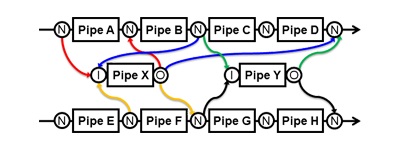| Latency(CLK) | 3 |
module product(
iData0, iData1, iData2, iData3,
iVld, iStall,
oData, oVld, oStall,
reset, clk);
parameter W = 32;
parameter S1 = 2'h1,
S2 = 2'h2,
S3 = 2'h3;
input [W-1:0] iData0, iData1, iData2, iData3;
input iVld;
output iStall;
output [W-1:0] oData; // Result
output oVld;
input oStall;
input reset;
input clk;
reg [1:0] state, stateD;
wire Stall = oVld & oStall;
reg [W-1:0] aIn, bIn;
wire [W-1:0] yOut;
reg oVld;
reg [W-1:0] oData, oDataD;
wire iAlloc = iVld & !iStall;
wire oAlloc = oVld & !oStall;
assign yOut = aIn * bIn; // Mul Resource (32bit clip)
always @(state or Stall or
oData or yOut or
iVld or iData0 or iData1 or iData2 or iData3) begin
stateD = state; // Default
oDataD = oData;
aIn = {W{1'bx}};
bIn = {W{1'bx}};
if (!Stall)
case (state)
S1: if (iVld) begin
stateD = S2;
{aIn, bIn, oDataD} = {iData0, iData1, yOut};
end
S2: begin
stateD = S3;
{aIn, bIn, oDataD} = {oData, iData2, yOut};
end
S3: begin
stateD = S1;
{aIn, bIn, oDataD} = {oData, iData3, yOut};
end
endcase
end
always @(posedge clk)
if (reset)
state <= #1 S1;
else
state <= #1 stateD;
always @(posedge clk)
if (reset)
oVld <= #1 1'b0;
else
oVld <= #1 (stateD == S3);
always @(posedge clk)
oData <= #1 oDataD;
assign iStall = iVld & (state != S3) | oStall;
endmodule
|







